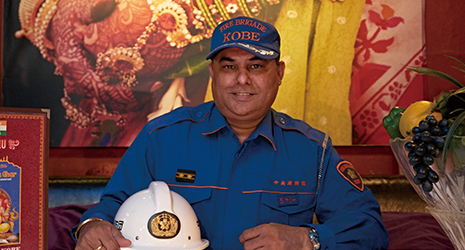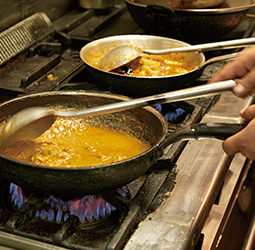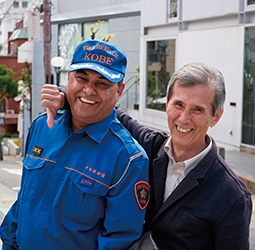Home > Highlighting JAPAN >Highlighting Japan January 2015>Home away from home
Highlighting JAPAN


Open Channel
An integral part of his neighborhood in Kobe for more than two decades, restaurateur Raja Dewan builds community through fine Indian cuisine, his skill with languages and a penchant for connecting and helping people.
Raja Dewan strolls down the street in Kobe’s Kitanocho district, greeting people left and right. “Hey boss!” he exclaims to one man. “How are you doing?” he says to a little girl, calling her by name. He waves at another man standing in line at the market, and hails a shopkeeper standing in front of her shop. A local business owner embraces him on the street corner. Voices come back in a chorus. “Raja-san! Good afternoon!”
Dewan is well known around these parts. The proprietor of the Indian restaurant Ganesha Ghar, he’s been local to this neighborhood—which is famous for its international flavor—for over twenty years. He’s a fixture not only when people come to his restaurant for a good time but in times of trouble too; he also serves as a volunteer firefighter.
When he first came to Japan from India in 1988, young Dewan landed in Tokyo to take a job in international sales. He worked hard to add Japanese to his linguistic repertoire that already included English, Hindi, Cantonese and a bit of Thai. After a year he moved to Kobe, where his uncle was in the restaurant business in Kitanocho. While working with his uncle, he also started a job at Mazda, interpreting for the Indian engineers who came over to study and work.
It was during this period that Dewan met his future wife. The pair married in 1992, and in 1994 their son was born. Just six months later, in January 1995, a massive earthquake hit Kobe. The Great Hanshin Earthquake, with a magnitude of 7.3, took the lives of over six thousand people. Already at work early on that fateful morning, Dewan rushed back home to his wife and infant son in their apartment on the thirty-fifth floor. Miraculously, the building was still standing and they were both unharmed.
In the months that followed, Kobe slowly began to recover from the disaster. Yet many areas of the city were in tatters, and reconstruction was sporadic. Kitanocho was still in ruins, with many buildings destroyed, but among them Dewan found one building that was still intact and stable. “You can use it, and pay as much as you want in rent,” its owner told him. “Please do something!”
Ganesha Ghar, named for the Hindu deity with the head of an elephant, opened in early 1996. The restaurant has a shrine to Ganesha, the god of beginnings and the remover of obstacles, an apt symbol for both the restaurant and the neighborhood.
The eatery soon became popular with students and the neighborhood, and new immigrants and visitors to the area would often drop in for food and advice. Dewan would help them make connections, read letters, or do a bit of interpretation for people in the community.
He says he doesn’t mind helping people. “It’s not for money,” he notes. “It’s just my job. Maybe God said for them to call Raja.” His daughter was born a few years after the restaurant opened, and he would often contribute food to school festivals, preparing pint-sized portions of breads, vegetables and curries for the kids. The tasty snacks were consumed with delight.
In around 2000, firmly entrenched in the country and the community, Dewan became a Japanese citizen, his passport finally matching that of his wife and children. “I don’t want to go back to India,” says Dewan, “because my family is here, everyone is here. And I am here.” As his restaurant business grew, he continued to interpret, both for large companies such as Mitsubishi Motors, where he worked for five years in this capacity, and for community members and important residents such as Kobe’s mayor, the Indian consul general and the Indian ambassador.
In 2013, wanting to give back to the community where the memory of the earthquake still lingers, Dewan trained to become a volunteer firefighter. Knowing the neighborhood as intimately as he does, he can help determine routes, direct traffic and guide fire trucks to the scene. He is also able to warn community members of danger, since he knows everyone and speaks several languages.
When asked why he does all this, it always comes back to family. “I wanted to do something for this area, so the kids can be proud of something,” he says. “These kids grew up in Kitanocho—and so did I.”
© 2009 Cabinet Office, Government of Japan








